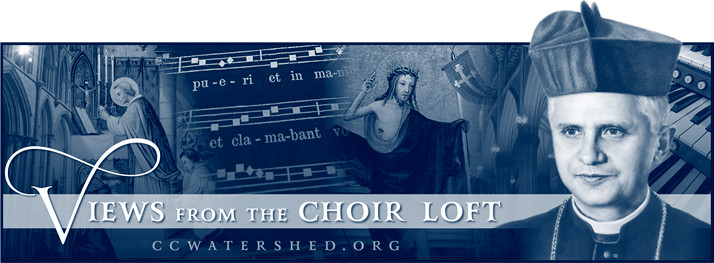 AVE YOU BEEN frustrated in your search for a reliable approach to Gregorian chant rhythm? This topic has been the cause of much controversy. Some choir directors adhere to the rhythmic system developed by Dom Mocquereau about 110 years ago. In my experience, those little ictuses under certain notes are the most commonly asked-about marking among people who are new to Gregorian chant. In fact, just yesterday someone stopped me in my church parking lot between Masses to ask me what they mean. (How does one explain without mincing words?)
AVE YOU BEEN frustrated in your search for a reliable approach to Gregorian chant rhythm? This topic has been the cause of much controversy. Some choir directors adhere to the rhythmic system developed by Dom Mocquereau about 110 years ago. In my experience, those little ictuses under certain notes are the most commonly asked-about marking among people who are new to Gregorian chant. In fact, just yesterday someone stopped me in my church parking lot between Masses to ask me what they mean. (How does one explain without mincing words?) 
If you’re ambivalent about the Dom Mocquereau system, then you’ve probably delved into the marvelous Graduale Triplex, which provides semiological markings from the Laon and Saint-Gall manuscripts above and below the neumes from the Vatican Edition. You may have also read Dom Cardine’s landmark 1982 work, Gregorian Semiology. (I would probably have a Dom Cardine poster over my bed if such a thing existed—and if I weren’t married.)
Having the semiology—and in particular, the Laon neumes—at our disposal is a big help in determining the proper rhythm of a particular chant. But there’s a translation that takes place on the fly; a singer must keep one eye on the square notes and another on the “chicken scratch.”
Hoping to overcome this challenge, many choir directors (including me) have taken to editing the propers using such handy resources as the Illuminare Score Editor and Gregobase. Still, the questions about rhythm abound: “Are we taking time on that last note before the descent?” “Should those next two notes be a little lighter, or are they equal to the others?” The central problem is that the commonly accepted system of chant neumes doesn’t allow for fine distinctions of rhythm. We can use horizontal episemas (lines) or dots to indicate the lengthening of notes. We can remind our singers that these signs aren’t meant to double the notes, but rather to indicate only a slight lengthening. Nevertheless, rhythm often remains a tug-of-war.
That’s why I’m excited to announce a new resource for chant propers: Gradule Renovatum, developed by my good friend Royce Nickel.
Meet the Man Behind Graduale Renovatum
If you’ve dug into the many resources Corpus Christi Watershed has to offer, Royce Nickel’s name will ring a bell. He has composed beautiful yet accessible settings of the Responsorial Psalms and Gospel Acclamations for the Ordinary Form. Royce described his approach to this project in a 2013 guest article.
I’ve had the privilege of calling Royce my friend for about nine years. He joined the St. Blaise Schola Cantorum in Fresno, California while I was still the director. As I prepared to move to Sacramento in 2014, Royce graciously agreed to take the reins. He has since brought the schola to a new level of artistry. Meanwhile, the Fresno Latin Mass community is now Holy Cross Chaplaincy, administered by the Priestly Fraternity of St. Peter. How fitting, then, that I should be writing this article on the Feast of the Exaltation of the Holy Cross (which, by the way, is a felicitous mixture of two of my favorite liturgies: Holy Thursday and Good Friday). Happy feast day to Royce and his Fresno colleagues!
Capturing the Rhythmic Nuances of Gregorian Chant
Over the years, various chant scholars have issued reformed manuscripts that corrected wrong notes in the Vatican Edition and perhaps attempted to clarify Gregorian rhythm. What’s different about Graduale Renovatum is that the manuscripts indicate rhythm by repurposing two existing elements of chant notation: 
-
Note shapes. You’ll still see virgas, punctums, and diamond-shaped notes, but now they have a specific rhythmic significance. You’ll also see a few signs that don’t appear in the Vatican Edition but do show up in more recent scholarly editions such as Graduale Novum.
-
Note spacing. The amount of space between notes indicates their relative rhythmic value and function.
For an in-depth description of the rationale behind Graduale Renovatum, I highly recommend you read Royce’s essay, Reformed Chant Notation: An Introduction to Method and Rationale.
But why go to all this effort? Royce explains at length in his essay. To me, this sentence sums it up:
The singer needs to be able to see in the notation which note or notes bear the weight of the syllable and represent the melody’s underlying structure and which of the notes are an ornamentation of that structure.
Royce is generously posting the manuscripts of Graduale Renovatum online for free download. Many (including those for the next several Sundays) are already available—so check out Gradule Renovatum now. I’m looking forward to bringing these propers to my choir and will share the results in a future article.

